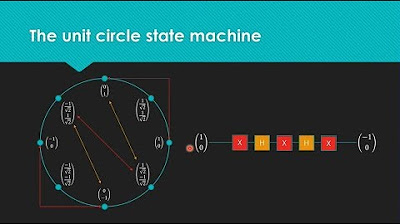10 weird algorithms
TLDRThis engaging script takes viewers on a fascinating exploration of groundbreaking algorithms that shape our digital world. From the marching cubes algorithm that revolutionized medical imaging to the quantum computing marvels like Shor's algorithm and the intriguing possibilities of quantum BOGO sort, the video delves into the realms of cryptography, procedural generation, and artificial intelligence. It unveils the ingenious simplicity of algorithms like sleep sort and the emerging complexity of flocking simulations, while also shedding light on the challenges of distributed systems through the Byzantine Generals problem. With a blend of technical insights and witty humor, this script promises an enthralling journey through the most interesting algorithms ever engineered.
Takeaways
- 🤖 The video discusses 10 interesting algorithms and their real-world applications, including wave function collapse for procedural map generation, diffusion for image generation, simulated annealing for optimization, and more.
- 🧩 The marching cubes algorithm, created in 1987, revolutionized medical imaging by allowing 3D visualization of CT and MRI scan data.
- 🔐 The RSA algorithm, based on the difficulty of factoring large prime numbers, is essential for digital security and encryption on the internet.
- 🔮 Shor's algorithm, if implemented on a powerful quantum computer, could potentially break RSA encryption by factoring large numbers exponentially faster than classical algorithms.
- 🌐 Algorithms like PBFT (Practical Byzantine Fault Tolerance) are crucial for maintaining consistency in distributed systems like blockchain and cloud databases, even when some nodes fail or are compromised.
- 🐦 Boids, an artificial life program created in 1986, demonstrates how complex flocking behavior can emerge from simple rules, reflecting natural phenomena.
- 🔎 The Boyer-Moore string search algorithm becomes more efficient as the search string grows longer, making it ideal for applications like the Unix grep command.
- 🎲 The video humorously discusses impractical sorting algorithms like sleep sort, which delegates sorting to the CPU scheduler, and quantum bogosort, which hypothetically sorts by observing parallel universes.
- 🧠 Algorithms can be weird, ingenious, or even indistinguishable from magic, showcasing the power and creativity of computer science.
- 🌎 Many algorithms are inspired by or reflect natural processes, such as simulated annealing (based on metalworking) and wave function collapse (based on quantum mechanics).
Q & A
What is the marching cubes algorithm, and why is it significant?
-The marching cubes algorithm is a technique used to extract a polygonal mesh from a three-dimensional discrete scalar field, such as data from CT or MRI scans. It was created and patented by two programmers at General Electric in 1987. The algorithm is significant because it allows doctors to visualize data from medical imaging scans in 3D, which has likely saved countless lives.
How does the wave function collapse algorithm work in procedural generation?
-The wave function collapse algorithm treats an initial game map as being in a 'superposition' of all possibilities. Upon 'observation' (running the algorithm), the map 'collapses' into a specific instance, following a set of rules to ensure cohesive and connected results. This allows for procedural generation of game levels or maps on the fly.
What is the diffusion algorithm used for in AI, and how does it work?
-The diffusion algorithm is used for tasks like image generation in AI systems like DALL-E and Stable Diffusion. It starts with random noise and gradually refines it into a structured image. The process involves two phases: a forward phase where noise is progressively added to an image until it's completely random, and a reverse phase where the algorithm reconstructs the image back into a coherent state using a trained model.
What is simulated annealing, and how can it be applied to programming?
-Simulated annealing is an optimization algorithm inspired by the process of heating and cooling metals to remove defects. In programming, it can be used to find the best solution among many good solutions by initially exploring a wide range of possibilities (high 'temperature'), and gradually narrowing the search to more optimal solutions (lower 'temperature'). This trade-off between exploration and exploitation is useful for beginners learning to code.
Why is the sleep sort algorithm considered ingenious yet useless?
-The sleep sort algorithm is considered ingenious because it delegates the sorting task to the CPU scheduler by creating a new thread for each element in the array and having it sleep for a time proportional to the element's value. However, it's also considered useless because delegating sorting to the CPU scheduler is an inefficient and unconventional approach.
How does the RSA algorithm work, and why is it important for digital security?
-The RSA algorithm is a public-key cryptosystem that allows for secure communication over the internet. It relies on the mathematical reality that factoring the product of two large prime numbers is extremely difficult and time-consuming. This allows for the creation of public and private keys that can be used to encrypt and decrypt messages securely. RSA is essential for digital security, enabling things like secure online transactions and communication.
What is the Byzantine generals problem, and how do algorithms like PBFT solve it?
-The Byzantine generals problem is a thought experiment that illustrates the challenges of distributed systems, where some nodes may fail or be compromised. Algorithms like PBFT (Practical Byzantine Fault Tolerance) solve this by ensuring that the system can continue to operate correctly even if up to one-third of its nodes are faulty. They do this through a consensus process involving message broadcasting and agreement thresholds.
How does Boid's artificial life program simulate flocking behavior, and what is its significance?
-Boid's artificial life program simulates the flocking behavior of birds by following three simple rules: avoiding crowding, steering towards the average heading of the flock, and steering towards the center of mass of nearby flockmates. The significance of this program is that it demonstrates how complex, intricate patterns can emerge from a few simple rules, reflecting the beauty and complexity found in nature.
What makes the Boyer-Moore string search algorithm unique, and why is it efficient for larger strings?
-The Boyer-Moore string search algorithm is unique because it becomes faster and more efficient as the string it's searching becomes larger. This is because it scans text from right to left and uses pre-calculated tables to estimate how many characters it can safely skip based on mismatches or partial matches. With larger strings, it can skip a higher proportion of characters, making it more efficient.
What is the potential impact of quantum computing on algorithms like RSA and Shor's algorithm?
-Quantum computers have the potential to break algorithms like RSA that are based on the difficulty of factoring large numbers. This is because quantum algorithms like Shor's algorithm can factor integers exponentially faster than classical algorithms. If large-scale quantum computing becomes a reality, it could render current encryption methods obsolete, necessitating the development of new cryptographic systems that are resistant to quantum attacks.
Outlines
🤖 The Marching Cubes Algorithm: Visualizing the Invisible
This paragraph introduces the marching cubes algorithm, which was created in 1987 by programmers at General Electric. It discusses how this algorithm revolutionized the medical field by enabling doctors to visualize data from CT and MRI scans. The paragraph also highlights the importance of algorithms in solving complex problems and rearranging ones and zeros to create remarkable functionalities.
🧩 A Panoply of Perplexing Algorithms
This paragraph delves into a diverse array of fascinating algorithms. It begins by discussing the wave function collapse algorithm, which is inspired by the concept of wave-particle duality in quantum mechanics and is used for procedural generation in video games. The diffusion algorithm, originally developed at OpenAI, is explored, highlighting its application in image generation through tools like DALL-E and Stable Diffusion. The simulated annealing algorithm, inspired by the process of heating and cooling metals, is introduced as a way to find optimal solutions. The paragraph also covers sorting algorithms, including the quirky sleep sort, the infamous bogosort, and the hypothetical quantum bogosort. The RSA public-key cryptography algorithm is discussed, emphasizing its importance in digital security and the potential threat posed by quantum computers. The marching cubes algorithm is revisited in more detail, explaining how it transforms 3D scalar field data into polygonal meshes. The Byzantine generals problem and the Practical Byzantine Fault Tolerance (PBFT) algorithm are covered, highlighting their significance in distributed systems and blockchain technology. Finally, the paragraph touches on Boids, an artificial life program that simulates the flocking behavior of birds, and the Boyer-Moore string search algorithm, which becomes more efficient as the searched string gets larger.
Mindmap
Keywords
💡Algorithm
💡Procedural Generation
💡Artificial Intelligence
💡Optimization
💡Sorting
💡Cryptography
💡Quantum Computing
💡Visualization
💡Distributed Systems
💡Emergent Behavior
Highlights
The marching cubes algorithm, created by two programmers at General Electric in 1987, allows doctors to visualize data from CT and MRI scans by extracting a polygonal mesh of an isosurface from a three-dimensional discrete scalar field.
Wave function collapse is an algorithm that can procedurally generate infinite maps for video games by collapsing an initial superposition of all possibilities into a coherent, rule-following result.
Diffusion algorithms, originally developed at OpenAI, can generate images, audio, and potentially videos by gradually refining random noise into structured data through a reverse thermodynamics process.
Simulated annealing is an optimization algorithm that finds the best solution by mimicking the process of heating and cooling metals to remove defects, allowing for initial exploration and eventual exploitation.
Sleepsort is an unconventional sorting algorithm that delegates the sorting to the CPU scheduler by opening threads that sleep for a time proportional to the value of each element.
Quantum BOGO sort is a hypothetical algorithm that randomly observes parallel universes to find the sorted array and then travels to that universe using a portal gun, albeit with the ethical dilemma of killing one's parallel self.
RSA is a practical public-key cryptosystem algorithm that relies on the difficulty of factoring the product of two large prime numbers, ensuring digital security for now, but may be threatened by quantum computers running Shor's algorithm.
The Byzantine generals problem is a distributed systems problem addressed by algorithms like PBFT, which maintain consensus and consistency even if up to one-third of the nodes fail or are compromised.
Boids is an artificial life program that simulates the flocking behavior of birds using simple rules, demonstrating how complex patterns can emerge from basic algorithms.
Boyer-Moore string search algorithm becomes faster and more efficient as the search string grows larger, by skipping characters based on pre-calculated tables and heuristics, making it a highly practical algorithm for text processing.
Transcripts
5.0 / 5 (0 votes)
Thanks for rating:





